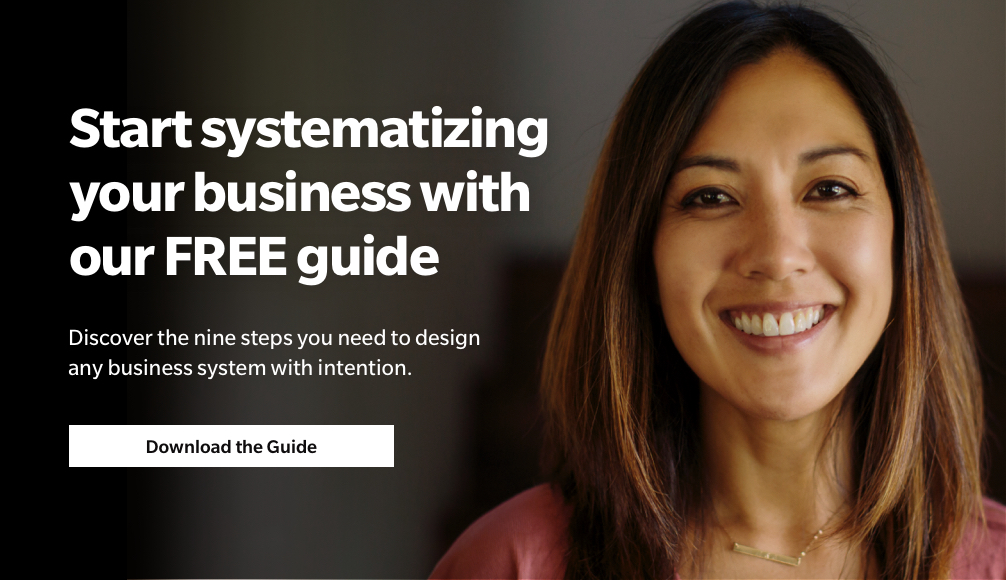When was the last time you thought about why your business does what it does? Every business exists for a singular purpose: to produce a certain result—a service or a product. But have you ever asked yourself, "Why do we do it this way?" This question is the essence of strategic thinking. And strategic thinking is the result of having a systemic perspective of your business that accomplishes what it does in a systematic way.
But what’s the difference between systemic and systematic thinking?
It’s understandable to confuse one word for the other or think of them as being interchangeable. But each term defines a specific and varied way of looking at your business—and together, these two modes of thinking help you to not only identify and resolve problems, but also consistently achieve the results you want.
The difference between “systemic” and “systematic” in business
Your business is essentially a system of systems. While it’s made up of hundreds and even thousands of moving parts that you need to manage—and which you may not even see clearly—these pieces all fit together. So when you look at your business with a systemic perspective, you can see it holistically. You recognize that all your many systems are interdependent and come together in an integrative way so that each part of your business affects the whole.
A systematic perspective, on the other hand, is about having documented methods, processes or systems that are repeatable and predictable so that your business can and will produce the same desired result each time, every time.
Put simply, a systemic perspective focuses on interrelatedness, while a systematic perspective focuses on results. And by knowing the difference, you can better see why you need both views to create a business that functions well and that doesn’t depend on you to make it function that way.
Let’s dig a little deeper.
What are the essential business systems?
Whether or not you’re aware of it, your business is already made up of systems—even if they’ve simply developed instead of you intentionally designing them. Every business is comprised of Seven Essential Systems that determine how it runs. Within those seven systems, there are four business disciplines which focus on the internal operations of your business—the performance and development of the business itself:
- Leadership
- Marketing (as a strategy)
- Finance
- Management
Then, there are the three business activities that focus on the external operations—the ways in which you and your business directly interact with and serve customers:
- Customer Fulfillment
- Lead Conversion
- Lead Generation
The four business disciplines provide the knowledge, information and structural foundation that inform the strategy behind the three business activities.
The systemic relationship between all your business systems
Systemic thinking is all about keeping the big picture in mind when considering what makes your business run—seeing the relationships between the parts and the whole and observing the overarching patterns at play.
While all Seven Essential Systems exist in your business today, you’ve likely only been focusing on a few of them. It’s common to be drawn into one issue in your business and try to solve or improve it without considering how that system issue touches other systems. But without seeing how they relate—where each system stops and the next starts—you can’t clearly understand how to improve them when needed.
For example, how can you generate leads without a strong marketing process, or hire new employees without an understanding of your finances? By practicing systemic thinking—keeping this holistic view that everything is interconnected—you’ll be able to more easily solve problems and produce the results you want.
Take a systematic approach to build each system well
What results do you want to achieve this year? Would you like to hire one or more employees to take over some key roles that you’re currently holding? Or raise your revenue by x%? Or increase your customer referral rate? Whether or not you have a clear business strategy, you likely have an idea of some goals you want to achieve, whether that’s by month, quarter or year. Systematic thinking is learning to identify the result you want and create a structured path to realize it. It allows you to consider each step, part or tiny detail, and make them work together to hit your goal.
When you take a systematic approach—recognizing and ordering patterns that you need to produce a result—you can break down each of your processes step by step to see what’s working and what isn’t.
An example of systemic and systematic issues in a business
When faced with a problem, business owners tend to reach for the closest, quickest solution—but this can bring significant costs down the road. For example, when you experience a sudden loss in revenue, a natural impulse is to cut back on something like advertising costs in order to save some money.
This is a tactical—rather than strategic—approach to solving a problem. Sure, this can help in the moment, but neglecting or making short-sighted changes to your marketing strategy can create a broader, crippling impact on lead generation and conversion down the road.
Here’s an example of how that can happen:
Imagine that you run a manufacturing company, and you see a need to decrease production costs in a small factory: You note that the assembly line produces an average of 100 widgets each month, yet you maintain raw materials for 150, so you decide to only stock materials for what’s being made. But soon, net production drops.
This could lead to the erroneous assumption that your assembly team’s productivity is slipping. But what you’ve failed to take into account is that the assembly line would produce between 50 to 150 widgets on any given month for an average of 100 widgets monthly: By limiting the raw materials at hand, you’ve inadvertently reduced production capacity.
Without a more detailed, systematic investigation into how the process happens, you’re blind to the real cause of the problem.
Often the biggest challenge in practicing these modes of thinking is developing the ability to see the "big picture". So it’s a common pitfall that, as a business owner who’s striving to improve, you may find yourself easily caught up in focusing more on systems—doing things right—at the expense of understanding whether you’re doing the right things to begin with.
It can be difficult to strike that balance on your own. But whether you’re feeling overwhelmed by the details, or can’t quite manage to see your business from a high level, we’re here to help.





Comments